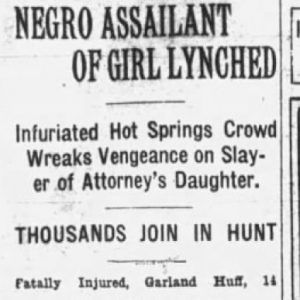calsfoundation@cals.org
Will Norman (Lynching of)
On June 19, 1913, twenty-one-year-old Will Norman was lynched in Hot Springs (Garland County) for the alleged assault and murder of Garland Huff, the daughter of Judge C. Floyd Huff.
In 1910, C. Floyd Huff was living in Hot Springs with his wife, Octavia, and four children: William (thirteen years old), Garland (eleven), C. Floyd Jr. (ten), and Robert E. C. (six). According to some reports, Will Norman had been employed by the Huffs for about two years prior to 1913. Little other information is available regarding him.
According to newspaper reports, on June 19, Norman dragged Garland Huff into a closet. When she resisted his advances, he beat her, crushing her skull in five places. He then locked her in the closet. One of her younger brothers discovered her and called for help, getting the attention of one of her other brothers. Garland was still alive at the time and managed to stand up. The family called a doctor, and she was taken to St. Joseph’s Infirmary. There, several doctors tried to save her, but she died soon after. According to the New York Sun, the only evidence against Norman was that he was seen running from the scene of the crime.
As soon as the incident became public knowledge, large crowds of armed men began to gather in Hot Springs. According to the Arkansas Gazette, those arming themselves for the manhunt included African Americans. Some accounts indicate that 3,000 men, accompanied by bloodhounds, participated in the search. According to the Gazette, “the woods were honeycombed with grim-visaged men determined to seek out and find the brute and silently acquiescing in a general scheme to make short work of him when he was found.”
At dusk, Norman was found by Tom McCafferty and Ernest Simms four miles from Hot Springs. They brought him back to town and attempted to put him in the jail, but because law enforcement officials were all involved in the search, the jail was locked. A mob of about 500 gathered. Members of the mob stripped Norman of his clothing and hanged him from an electrical pole at the corner of Ouachita and Central avenues, riddling his body with bullets.
About an hour after the lynching, the crowd decided to burn Norman’s body, and it was taken down, placed on a hastily gathered woodpile, and set on fire. According to the Gazette, “Within another five minutes the black outlines of the negro could be seen through the tongues of flames and within another half hour only the charred bones of the negro remained.” Several newspapers reported that there had never been so much excitement in Hot Springs, and the Washington Times indicated that the event took place “to the horror of hundreds of tourists, health-seekers, and law-abiding citizens.” The following day, “a morbid crowd” picked through the ashes, retrieving Norman’s charred bones and breaking them into small pieces to be handed out as souvenirs.
The following day, Circuit Judge Calvin T. Cotnam, while recognizing the seriousness of the crime and expressing his deepest sympathies to the Huff family, decried the use of mob violence. Describing the incident as “meeting barbarism with barbarism,” he noted a 1909 state law that permitted a circuit judge to call both a special grand jury and petit jury to deal immediately with cases in which mob violence was anticipated. Instead, Norman had been hanged under bright lights at the “most public place in our city.” According to Judge Cotnam, “We have been making a hard battle here for several years for the enforcement of the law,” and a trial in this case would have set a good example. He also noted that the incident would generate bad publicity for the town in newspapers in the North and East.
Garland Huff’s funeral was held on June 21. All streetcars were stopped during the funeral cortege, and downtown businesses closed for an hour.
The site where Norman and, later, Gilbert Harris were lynched is now occupied by the Hot Springs Confederate Monument.
For additional information:
“Hanged and Shot by Mob in City Street.” Washington Times (Washington DC), June 20, 1913, p. 3.
“Jurist Deplores Lynching of Negro.” Arkansas Gazette, June 21, 1913, p. 1.
Lancaster, Guy. “‘Let’s burn him’: The 1913 Lynching of Will Norman in Hot Springs.” The Record (2023): 4.1–4.28.
McDowell, Linda. “‘Most Atrocious Crime Ever Committed Here’: Lynching in Hot Springs—1913.” The Record (2002): 73–82.
“Negro Assailant of Girl Lynched.” Arkansas Gazette, June 20, 1913, pp. 1, 2
“Negro Lynched at Jail Door.” The Sun (New York City, New York), June 20, 1913, p. 1.
Nancy Snell Griffith
Davidson, North Carolina







Comments
No comments on this entry yet.